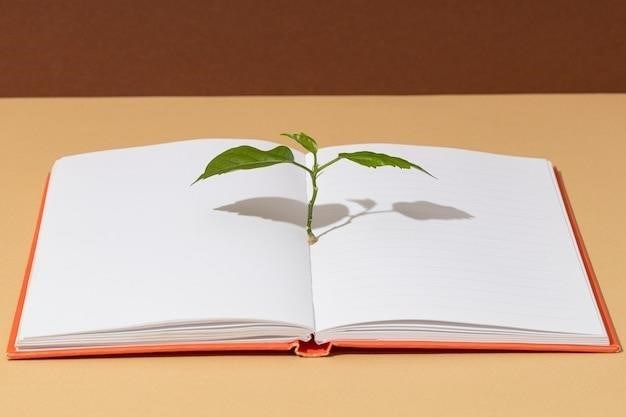The Bad Seed Book⁚ An Overview
The Bad Seed is a popular children’s book by Jory John and Pete Oswald that tells the story of a mischievous seed who learns the importance of being good. This humorous and heartwarming tale has captured the hearts of readers young and old, becoming a New York Times bestseller. The book is available in both physical and digital formats, with multiple online resources offering free downloads and previews. The Bad Seed has also spawned several spin-offs, including The Good Egg and The Cool Bean, further solidifying its place in children’s literature.
The Bad Seed⁚ A Children’s Book
The Bad Seed, a delightful children’s book written by Jory John and illustrated by Pete Oswald, is a charming tale about a mischievous seed who embarks on a journey of self-discovery. The book, part of the popular “Food Group” series, is a whimsical exploration of the power of positive change and the importance of being kind. The story unfolds with a humorous and endearing voice, captivating young readers with its relatable characters and engaging storyline.
The Bad Seed is a book about a seed with a bad temper, bad manners, and a bad attitude. He’s been bad since he can remember, cutting in line, staring at everyone, and never listening. However, when this mischievous little seed decides he wants to be happy, he embarks on a journey of self-improvement, learning to be kind, considerate, and ultimately, a good seed. The Bad Seed’s transformation highlights the remarkable power of will, acceptance, and being oneself.
The book’s charming and expressive illustrations by Pete Oswald perfectly complement Jory John’s witty and engaging text. Together, they create a vibrant and engaging reading experience that resonates with children of all ages. The Bad Seed is a perfect choice for bedtime stories, classroom read-alouds, or simply a fun and heartwarming book to enjoy with loved ones. It’s a reminder that positive change is possible for everyone, no matter how “bad” they might seem.
The Bad Seed⁚ A Classic Novel
In stark contrast to the lighthearted children’s book, “The Bad Seed” is a chilling psychological thriller novel by William March, published in 1954. This classic novel delves into the dark side of human nature, exploring themes of inherited evil and the disturbing possibility of a child born with a predisposition towards violence. The novel centers around Rhoda Penmark, a seemingly charming and innocent eight-year-old girl who harbors a sinister secret.
Rhoda’s seemingly angelic facade masks a cold, calculating, and manipulative personality. The novel unravels a series of unsettling events as Rhoda’s true nature is gradually revealed. Through her cunning and manipulative behavior, Rhoda orchestrates a series of tragic incidents, leaving a trail of destruction in her wake. The novel explores the unsettling question of whether evil is a learned behavior or an innate part of a person’s being.
“The Bad Seed” has been praised for its suspenseful plot, compelling characters, and chilling exploration of human nature. The novel has been adapted into numerous films, television series, and plays, captivating audiences with its unsettling portrayal of childhood innocence masking a sinister darkness. “The Bad Seed” is a timeless story that continues to haunt readers with its disturbing exploration of the darker side of human nature.
The Bad Seed⁚ Movie Adaptations
The chilling story of “The Bad Seed” has captivated audiences beyond the pages of the novel, inspiring multiple movie adaptations that have brought its unsettling themes to life on the silver screen. The most notable adaptation is the 1956 film starring Patty McCormack as Rhoda Penmark, a performance that earned her an Academy Award nomination for Best Supporting Actress. The film faithfully captures the chilling atmosphere of the novel, portraying Rhoda’s manipulative and violent nature with a chilling effectiveness.
The 1956 film became a cult classic, solidifying “The Bad Seed” as a symbol of cinematic suspense and psychological horror. It explored the unsettling nature of inherited evil and the disturbing possibility of a child capable of committing horrific acts. The film’s ending, though softened from the novel’s conclusion, still left a lasting impression on audiences, fueling debate about the nature of good and evil.
While the 1956 film remains the most iconic adaptation, “The Bad Seed” has also been adapted for television in 1985 and 2018. These adaptations have offered different interpretations of the story, exploring its themes in a contemporary context. However, the core elements of the novel, the chilling portrayal of a seemingly innocent child harboring a dark secret, remain consistent across all adaptations, ensuring “The Bad Seed” continues to resonate with audiences across generations.

Exploring the Bad Seed
Delving deeper into “The Bad Seed” reveals a compelling exploration of complex themes, intricate characters, and critical reception that has cemented its status as a thought-provoking work of literature.
The Bad Seed⁚ Themes and Motifs
The Bad Seed, despite its lighthearted tone, delves into several profound themes that resonate with both children and adults. One prominent theme is the power of self-reflection and change. The titular Bad Seed, initially characterized by his bad temper, bad manners, and overall bad attitude, undergoes a transformative journey. He realizes the negative impact his behavior has on others and embarks on a path of self-improvement, demonstrating that even the most mischievous characters can change for the better. This theme of personal growth and the potential for redemption is a powerful message for young readers.
Another key theme is the importance of kindness and empathy. The Bad Seed learns the value of treating others with respect and understanding. He recognizes that his actions have consequences and that his negativity affects those around him. This realization prompts him to adopt a more positive and compassionate approach, highlighting the significance of kindness in fostering healthy relationships and building a more positive world. This theme of empathy is particularly relevant in today’s society, where social interactions are increasingly complex and the need for understanding and compassion is paramount.
Throughout the story, various motifs reinforce these themes. The motif of “bad” and “good” serves as a constant reminder of the choices the Bad Seed makes and the consequences of his actions. This motif is further emphasized through the use of contrasting colors, with the Bad Seed often depicted in dark shades while other characters are represented in brighter hues. Additionally, the motif of “growing” symbolizes the Bad Seed’s journey of change, highlighting his gradual transformation from a mischievous seed to a more wholesome individual. These motifs work in tandem to create a compelling narrative that effectively conveys the book’s central messages about self-improvement, kindness, and the transformative power of change.
The Bad Seed⁚ Character Analysis
The Bad Seed, the protagonist of the book, is a complex and endearing character. He is initially presented as a mischievous and defiant seed, prone to bad behavior and a lack of consideration for others. His actions, such as cutting in line and staring rudely, highlight his selfish nature and his disregard for social norms. However, beneath his outward negativity lies a vulnerable and lonely seed who yearns for connection and acceptance. The book skillfully portrays this duality, showcasing both his destructive tendencies and his underlying desire for positive change.
The Bad Seed’s transformation is a key element of the story. His journey from bad to good is not a sudden shift but a gradual process of self-discovery. He begins to question his behavior and its consequences, gradually realizing that his actions are not bringing him happiness. This realization motivates him to change, leading him to embrace kindness, empathy, and cooperation. The book portrays this evolution with humor and sensitivity, making the Bad Seed’s transformation relatable and inspiring for young readers.
The supporting characters in the book, such as the friendly flowers and the patient sunflower, play crucial roles in the Bad Seed’s growth. They represent the positive influences in his life, encouraging him to be better and providing him with opportunities for growth. Their interactions with the Bad Seed highlight the power of kindness and support in fostering positive change. The book emphasizes the importance of surrounding oneself with positive influences and how these connections can contribute to personal growth and transformation.
The Bad Seed⁚ Critical Reception
The Bad Seed has garnered widespread acclaim from critics and readers alike, earning numerous accolades and establishing itself as a beloved children’s book. The book has been praised for its engaging storytelling, humorous illustrations, and relatable characters. Critics have lauded Jory John’s witty and clever writing, highlighting his ability to create a story that is both entertaining and thought-provoking. The Bad Seed’s message of self-improvement and the power of positive change has resonated with readers, prompting discussions about the importance of kindness, empathy, and personal growth.
The book’s illustrations by Pete Oswald have been equally praised for their vibrant colors, expressive characters, and playful style. Oswald’s illustrations perfectly complement John’s text, bringing the story to life and adding another layer of humor and charm. The book’s unique combination of engaging text and captivating illustrations has made it a favorite among children and adults, earning it a place on numerous “Best Books” lists and establishing it as a must-read for young readers.
The Bad Seed has also been recognized for its ability to spark conversations about self-acceptance and the importance of celebrating individual differences. The book’s message that everyone has the potential to change and grow has resonated with readers of all ages, promoting positive values and encouraging self-reflection. The book’s critical reception highlights its enduring appeal and its ability to connect with readers on a personal and meaningful level.

Finding The Bad Seed
Acquiring a copy of “The Bad Seed” is a simple process, with numerous options available for both physical and digital formats. Readers can find the book at local bookstores, online retailers like Amazon, or through digital platforms like Kindle.
The Bad Seed⁚ Book Availability
Securing a copy of “The Bad Seed” is a straightforward endeavor, with multiple avenues catering to both physical and digital preferences. For those seeking a tangible book, local bookstores are a readily accessible option, offering a hands-on browsing experience and the opportunity to peruse the book’s vibrant illustrations. Online retailers, such as Amazon, provide a convenient alternative, allowing for doorstep delivery and a wider selection, including various editions and formats. The digital realm presents an equally convenient option with platforms like Kindle offering instant access to the book’s captivating narrative. Readers can download the ebook directly onto their devices, eliminating the need for physical storage and providing on-the-go reading convenience.
Furthermore, numerous websites dedicated to sharing and distributing digital content provide free access to “The Bad Seed” in PDF format. These platforms, often frequented by avid readers and book enthusiasts, offer a cost-effective way to enjoy the story. However, it is crucial to ensure that these websites adhere to copyright regulations and obtain the necessary permissions before downloading and sharing copyrighted materials.
Regardless of the chosen method, “The Bad Seed” is readily available, allowing readers of all ages to embark on a journey of laughter, learning, and heartwarming discoveries alongside the mischievous seed.
The Bad Seed⁚ Online Resources
For those seeking a deeper dive into the world of “The Bad Seed,” online forums and communities offer valuable insights and discussions. Readers can connect with fellow enthusiasts, engage in lively debates about the book’s themes, characters, and overall message, and share their personal interpretations. These online spaces also provide a platform for exchanging recommendations for related works and exploring the broader literary landscape.
Furthermore, educational websites like Teachers Pay Teachers offer a treasure trove of resources specifically designed for educators and parents seeking to incorporate “The Bad Seed” into their curriculum or reading time. These resources include lesson plans, activity sheets, and interactive games, all aimed at enhancing the learning experience and fostering a deeper understanding of the book’s message.
The Bad Seed⁚ Related Works
The Bad Seed is not just a standalone book but part of a larger universe of heartwarming and humorous children’s literature created by Jory John and Pete Oswald. This series, fondly known as “The Food Group,” features a cast of charming characters, each representing a different aspect of personality and life lessons. The Good Egg, a well-intentioned but sometimes misguided egg, serves as a foil to The Bad Seed, showcasing the importance of kindness and generosity. The Cool Bean, a character known for his confidence and swagger, explores the themes of self-acceptance and embracing one’s individuality.
The Bad Seed series also expands beyond the core characters, featuring spin-off stories that delve deeper into the lives and adventures of these lovable characters. The Bad Seed Presents⁚ The Good, the Bad, and the Spooky! and The Good Egg Presents⁚ The Great Eggscape! are two examples of these spin-offs, offering further exploration of the series’ themes and characters. These related works provide readers with a rich and engaging literary landscape, encouraging them to explore the nuances of each character and the universal messages embedded within their stories.
Beyond the “Food Group,” The Bad Seed finds its place in a broader genre of children’s literature that focuses on themes of self-discovery, personal growth, and the power of positive change. This genre encompasses works that encourage young readers to embrace their individuality, challenge societal norms, and strive to be their best selves. The Bad Seed’s message of transformation and the power of choice resonates with readers of all ages, making it a timeless and relevant addition to this vibrant and engaging genre.


